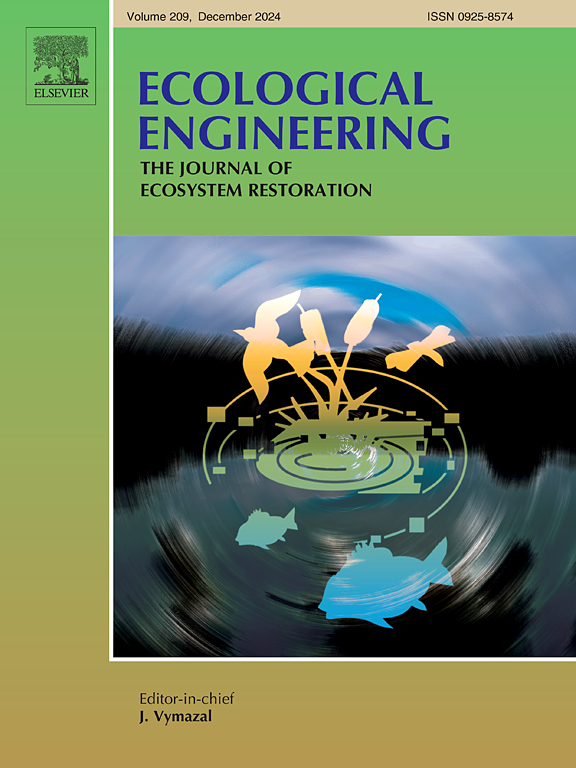Nitrogen removal in vertical flow constructed wetlands: The influence of recirculation and partial saturation
IF 3.9
2区 环境科学与生态学
Q1 ECOLOGY
引用次数: 0
Abstract
This study aims to evaluate the performance of a vertical flow constructed wetland (VFCW) with an area of 24.50 m2 for nitrogen removal under two different operational strategies: effluent recirculation and partial saturation. The system operated over two phases. In Phase 1, recirculation was applied with a hydraulic loading rate (HLR) of 90 mm d−1, while in Phase 2, recirculation was halted, and a 25 cm saturated layer was introduced at the bottom of the VFCW, with an HLR of 57 mm d−1. The efficiency of the system in removing chemical oxygen demand (COD), total suspended solids (TSS), ammonia nitrogen (NH₄+-N), and total nitrogen (TN) was compared between the two phases. In Phase 1, removal efficiencies of 88 %, 92 %, 79 %, and 70 % were recorded for COD, TSS, NH₄+-N, and TN, respectively. In Phase 2, the system achieved 93 %, 95 %, 61 %, and 69 % removal for COD, TSS, NH₄+-N, and TN, respectively. Statistically, there were no significant differences in COD and TN removal between the two phases, suggesting that partial saturation can perform comparably to recirculation. However, partial saturation offers the added benefits of reduced energy consumption (no need for pumping) and operational simplicity. The results underscore the potential of partially saturated VFCWs as a cost-effective, energy-efficient alternative for decentralized wastewater treatment, particularly where minimizing operational complexity is a priority.
求助全文
约1分钟内获得全文
求助全文
来源期刊

Ecological Engineering
环境科学-工程:环境
CiteScore
8.00
自引率
5.30%
发文量
293
审稿时长
57 days
期刊介绍:
Ecological engineering has been defined as the design of ecosystems for the mutual benefit of humans and nature. The journal is meant for ecologists who, because of their research interests or occupation, are involved in designing, monitoring, or restoring ecosystems, and can serve as a bridge between ecologists and engineers.
Specific topics covered in the journal include: habitat reconstruction; ecotechnology; synthetic ecology; bioengineering; restoration ecology; ecology conservation; ecosystem rehabilitation; stream and river restoration; reclamation ecology; non-renewable resource conservation. Descriptions of specific applications of ecological engineering are acceptable only when situated within context of adding novelty to current research and emphasizing ecosystem restoration. We do not accept purely descriptive reports on ecosystem structures (such as vegetation surveys), purely physical assessment of materials that can be used for ecological restoration, small-model studies carried out in the laboratory or greenhouse with artificial (waste)water or crop studies, or case studies on conventional wastewater treatment and eutrophication that do not offer an ecosystem restoration approach within the paper.
 求助内容:
求助内容: 应助结果提醒方式:
应助结果提醒方式:


